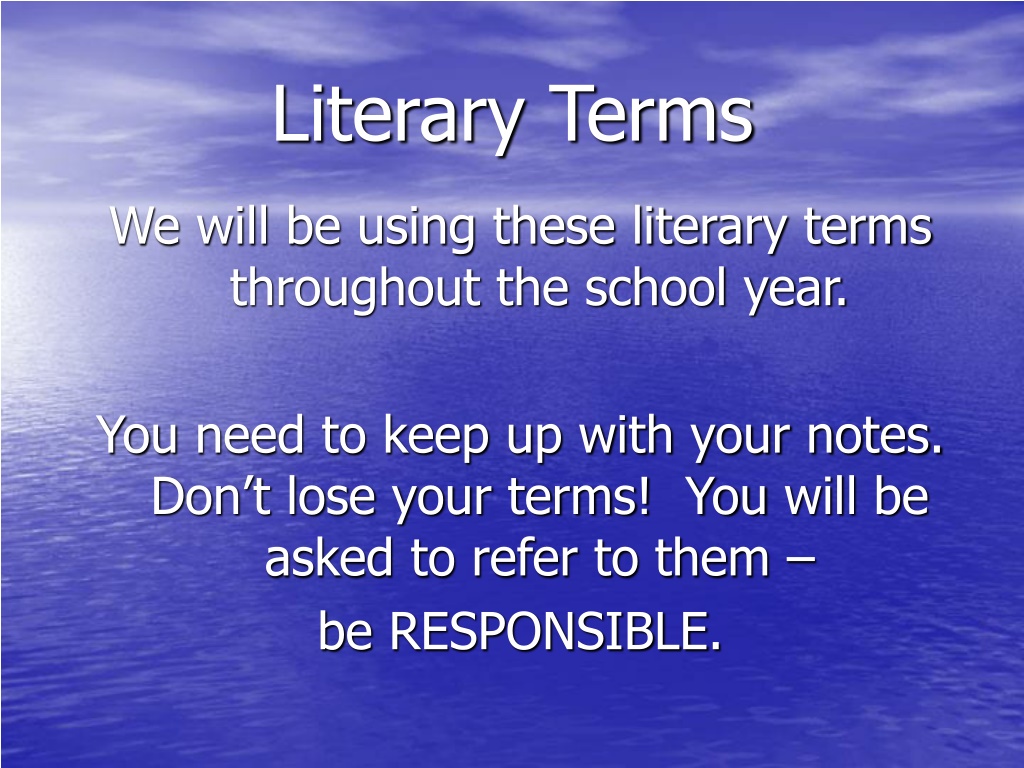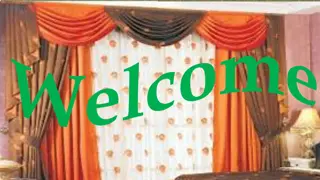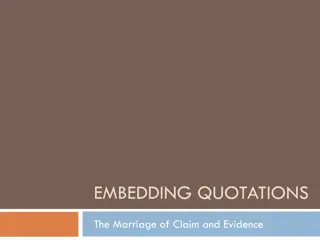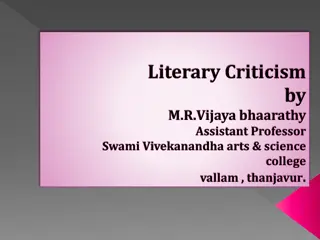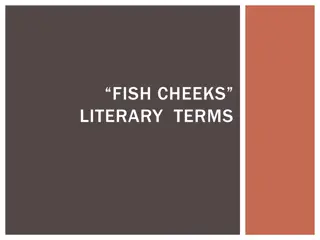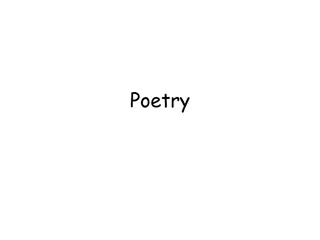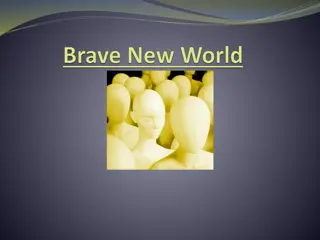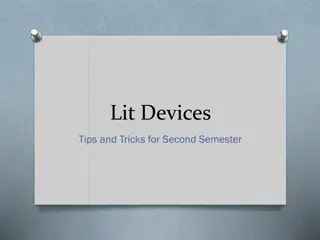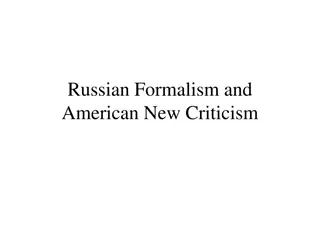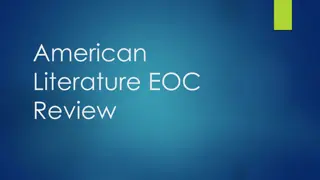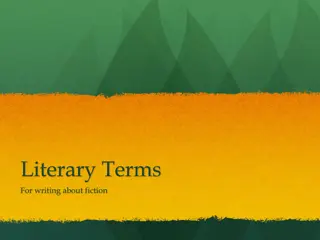Literary Terms Guide for Academic Year
In preparation for the upcoming school year, familiarize yourself with key literary terms such as Character, Diction, Imagery, Exposition, and more. Understand the roles of Antagonists and Protagonists, learn about Diction, Denotation, Connotation, and how they shape writing. Enhance your understanding of literature through these essential terms.
Download Presentation

Please find below an Image/Link to download the presentation.
The content on the website is provided AS IS for your information and personal use only. It may not be sold, licensed, or shared on other websites without obtaining consent from the author.If you encounter any issues during the download, it is possible that the publisher has removed the file from their server.
You are allowed to download the files provided on this website for personal or commercial use, subject to the condition that they are used lawfully. All files are the property of their respective owners.
The content on the website is provided AS IS for your information and personal use only. It may not be sold, licensed, or shared on other websites without obtaining consent from the author.
E N D
Presentation Transcript
Literary Terms We will be using these literary terms throughout the school year. You need to keep up with your notes. Don t lose your terms! You will be asked to refer to them be RESPONSIBLE.
We will use the following terms: Character Diction Imagery Exposition Falling Action Flashback Point of View Theme Antagonist Denotation Mood Rising Action Resolution Foreshadowing Setting Tone Protagonist Connotation Plot Climax Conflict Suspense Style
Character A character is a person or an animal that takes part in the action of a literary work.
Antagonist The Antagonist is a character or force in conflict with a hero, or protagonist.
Do you know your Antagonists? On your paper take a few minutes to write down some antagonists that you can recall from movies, television shows, and video games Remember the antagonist is in conflict with the protagonist/hero! Helpful hint you should now know why people use the saying Don t antagonize me!
Protagonist The protagonist is the hero/heroine -typically the main character in a literary work. Can you name some famous protagonists that are found in literature?
Diction Diction is the manner in which we express words; the wording used. It refers to specific word choices
Denotation The denotation of a word is its literal, dictionary meaning, independent of other associations that the word may have.
Connotation The connotation of a word is the set of ideas (emotions) associated with it in addition to its explicit meaning. The connotation of a word can be personal, based on individual experiences. More often, cultural connotations those recognizable by most people in a group determine a writer s word choices.
Denotation versus Connotation Some examples Cheap is low in cost (denotation) but stingy or poorly made are the connotations of cheap Does cheap have a positive or negative connotation?
Imagery Imagery is words or phrases that appeal to one or more of the five senses. Writers use imagery to describe how their subjects look, sound, feel, taste, and smell.
MOOD Mood, or atmosphere, is the feeling created in the reader by a literary work or passage. Writer s use many devices to create mood, including images, dialogue, setting, and plot. Often, a writer creates a mood at the beginning of a work and then sustains the mood throughout. Sometimes, however, the mood of the work changes dramatically. TIP: Mood = Me (it s about the reader)
Tone Tone is a reflection of a writer s or speaker s attitude toward a subject of a poem, story, or other literary work. For example, word choice or phrasing may seem to convey respect, anger, lightheartedness, or sarcasm. Remember that mood refers to the reader s feelings while tone refers to the author s attitude.
Plot Plot is the sequence of events. The first event causes the second, the second causes the third, and so forth. The plot usually begins with an exposition that introduces the setting, the characters, and the basic situation. This is introduced and developed. The conflict then increases (rising action) until it reaches a high point of interest or suspense, the climax. The climax is followed by the falling action, or end, of the central conflict. Any events that occur during the falling action make up the resolution.
PLOTLINE Climax Resolution Exposition Conflict Introduced
Exposition The exposition is the introduction. It is the part of the work that introduces the characters, setting, and basic situation.
Rising Action Rising action is the part of the plot that begins to occur as soon as the conflict is introduced. The rising action adds complications to the conflict and increases reader interest.
Climax The climax is the point of greatest emotional intensity, interest, or suspense in the plot of a narrative. The climax typically comes at the turning point in a story or drama.
Falling Action Falling action is the action that typically follows the climax and reveals its results.
Resolution The resolution is the part of the plot that concludes the falling action by revealing or suggesting the outcome of the conflict.
Conflict Conflict is the struggle between opposing forces in a story or play. There are two types of conflict that exist in literature.
External Conflict External conflict exists when a character struggles against some outside force, such as another character, nature, society, or fate. Man vs. Man Man vs. Society Man vs. Nature
Internal Conflict Internal conflict exists within the mind of a character who is torn between different courses of action. Man vs. Self
Flashback A flashback is a literary device in which an earlier episode, conversation, or event is inserted into the sequence of events. Often flashbacks are presented as a memory of the narrator or of another character.
Foreshadowing Foreshadowing is the author s use of clues to hint at what might happen later in the story. Writers use foreshadowing to build their readers expectations and to create suspense. This is used to help readers prepare for what is to come. TIP: look for clues in strong warnings and seemingly unrelated comments
Suspense Suspense is the growing interest and excitement readers experience while awaiting a climax or resolution in a work of literature. It is a feeling of anxious uncertainty about the outcome of events. Writers create suspense by raising questions in the minds of their readers.
Point of View Point of View is the perspective, or vantage point, from which a story is told. It is the relationship of the narrator to the story. 1st person is told by a character who uses the first- person pronoun I . 3rd person - the narrator is not a character (uses third-person pronouns such as he and she to refer to the characters) 3rd person limited - the narrator is not a character but can read the thoughts/emotions of a single character 3rd person omniscient - the narrator is not a character but can read the thoughts/emotions all of the characters
Setting The setting of a literary work is the time and place of the action. The setting includes all the details of a place and time the year, the time of day, even the weather. The place may be a specific country, state, region, community, neighborhood, building, institution, or home. Details such as dialect, clothing, customs, and modes of transportation are often used to establish setting. In most stories, the setting serves as a backdrop a context in which the characters interact. The setting of a story often helps to create a particular mood, or feeling and can help to set up the conflicts.
Style Style is the distinctive way in which an author uses language. Word choice (DICTION), phrasing, sentence length, dialogue, purpose, and tone (attitude toward the audience and subject) can all contribute to an author s writing style.
Theme The theme of a literary work is its central message, concern, or purpose. A theme is a universal statement about people or life. The theme may be stated directly by the writer although it is more often presented indirectly. When the theme is stated indirectly, the reader must figure out the theme by looking carefully at what the work reveals about the people or about life.
Theme Tips The theme is NOT one word (ex: love or friendship). Think about what the author is trying to say about those universal ideas and turn it into sentence/statement of fact (ex: Love is blind. Or, love conquers all.) The theme should be supported by events/character actions, but it should be also be a universal idea (not limited to that one text).
